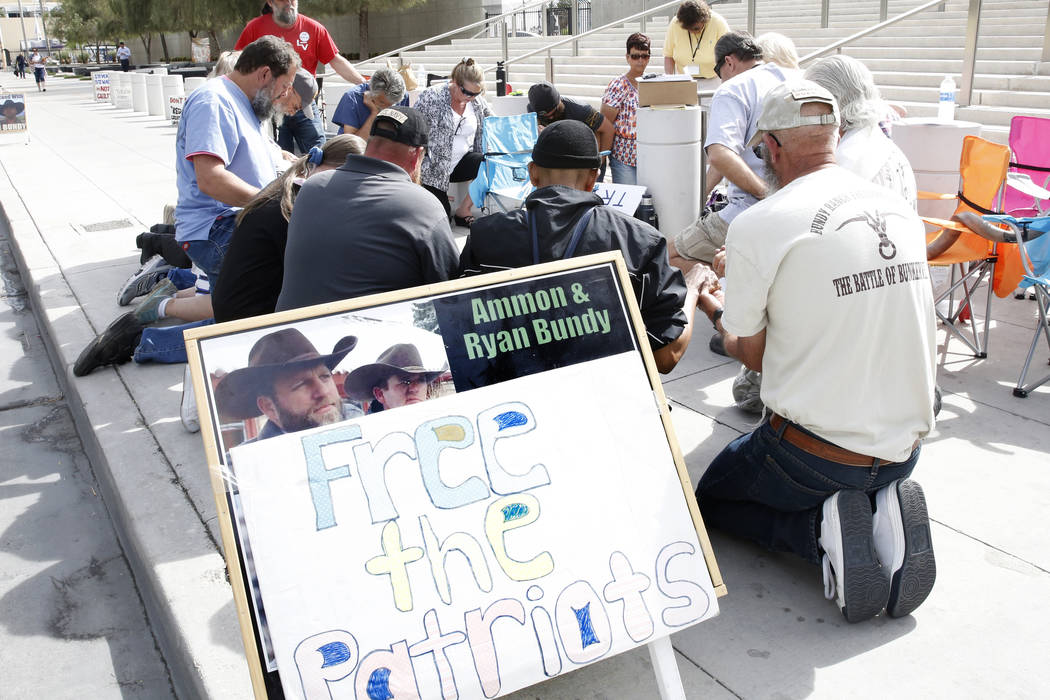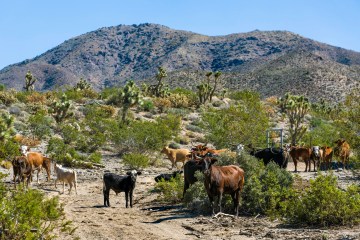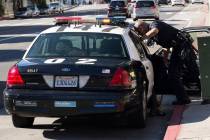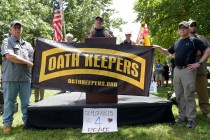Retrial in Bunkerville standoff case opens with jury selection
A federal judge dealt a blow to defense lawyers in the Bunkerville standoff case Monday with an early-morning ruling that obliterates the strategy they used in the first trial this year.
The order, from U.S. District Judge Gloria Navarro, came hours before prosecutors and defense attorneys started selecting a jury for the retrial against four men accused of conspiring against the government with rancher Cliven Bundy. In April, a jury deadlocked on all counts against Eric Parker, Steven Stewart, Scott Drexler and Ricky Lovelien.
Prosecutors characterize the defendants as violent zealots whose blatant disregard for the rule of law put hundreds of lives in danger. Defense attorneys, meanwhile, describe their clients as passionate but peaceful protesters who, during the April 2014 standoff, exercised their constitutional rights against a militant federal law enforcement presence.
But much of that defense narrative was invalidated Monday by Navarro’s ruling, which amounts to a blanket ban on evidence that comprised the heart of the strategy in the first trial.
“It changes the landscape of where we need to go with our defense, but it doesn’t change the government’s high burden to prove the case,” said defense attorney Todd Leventhal, who represents Drexler. “Despite this uphill battle, we’ll keep fighting.”
Defense attorneys no longer will be allowed to argue that their clients were exercising their First and Second Amendment rights to freely assemble and to bear arms when, in April 2014, they brought their guns to the site where federal agents tried to round up Bundy’s cows.
“The law does not recognize these amendments as legal defenses to the crimes charged,” Navarro wrote.
The order also prohibits defense lawyers from calling people to testify about federal agents’ actions in the days leading up to the standoff, when law enforcement officers used stun guns and police dogs to control angry protesters. Such actions led the Bundy family to issue a call to arms on social media, in which they implored other individual rights activists to drive to the family ranch.
Defense attorneys had argued that they should be allowed to bring in that sort of evidence in order to prove their clients’ “non-criminal state of mind” when they tossed their guns in their cars and drove to Bunkerville to join the ballooning protests.
But Navarro wrote in her ruling that if “evidence is not relevant to any of the elements of a charge or a cognizable defense to that charge, the evidence is not admissible.”
For the same reason, the defendants are prohibited from arguing that they brought their weapons for self-defense against an excessively forceful police presence. The four men are charged as “gunmen,” accused of supplying the force behind a conspiracy to stop the cattle seizure.
The government also was handed a victory Monday when, in a separate order, Navarro ruled that prosecutors can introduce evidence related to the defendants’ prior association with militia groups.
The lengthy process of selecting a jury started Monday and is expected to last several days. Parker, Stewart, Drexler and Lovelien are being tried on charges of conspiracy, assault, threats, extortion and related counts for their role in the 2014 standoff between gun rights activists and federal agents.
Defense attorneys Jess Marchese, Rich Tanasi and Todd Leventhal — the lawyers for Parker, Stewart and Drexler — came to court Monday dressed in matching ties, which were emblazoned with passages from the U.S. Constitution. On each tie, the phrase “We the People” was highlighted in large, bold font.
Contact Jenny Wilson at jenwilson@reviewjournal.com or 702-384-8710. Follow @jennydwilson on Twitter.
The judge's ruling specifically prohibits defense attorneys from mentioning the following:
-Officers' encounters with civilians during the arrest of Dave Bundy, the rancher's son, a week before the standoff.
-Officers' encounters with Margaret Houston, a middle-aged grandmother who was tackled to the ground by a BLM agent days before the standoff. Prosecutors argue Houston was in the way of an oncoming truck; defense attorneys contend the force was excessive.
-Testimony about the level of force used by law enforcement officers. In the days leading up to the protest, law enforcement officers used stun guns and police dogs to control the crowds. On the day of the standoff, federal police armed themselves, donned SWAT gear, and assumed military "stacking formation."
-A statement that Nevada Gov. Brian Sandoval issued four days before the standoff, in which he condemned federal agents' actions.
-References to First Amendment zones. Days before the standoff, federal agents cordoned off a First Amendment zone for protesters in the middle of the desert.
-Arguments about Bundy's grazing, water or legacy rights on the public lands. Bundy let his cattle roam free on public lands for decades but refused to obtain grazing permits. He maintains that the federal government does not have jurisdiction over the land.
-First and Second Amendment rights to freely assemble and to bear arms.
-Punishments the defendants may face if convicted of the offenses.
Related
Questions remain after mistrial in Bunkerville standoff case























